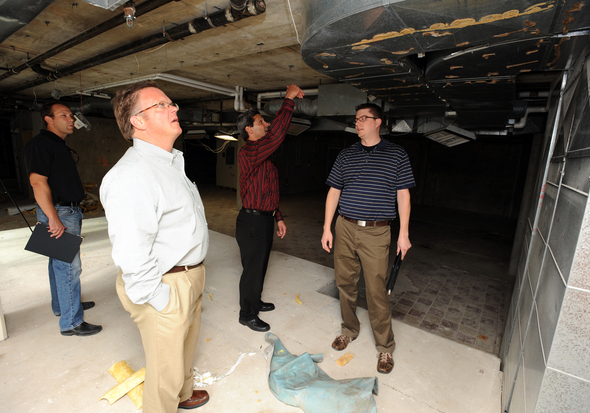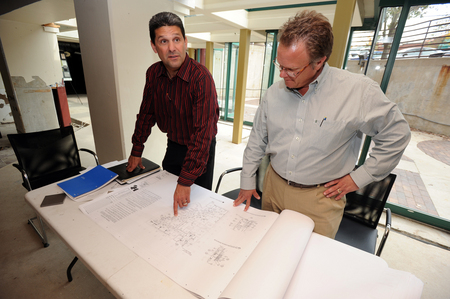MAV Development installing geo-thermal heating system in downtown Ann Arbor building

MAVDevelopment Vice Presidents Mark Melchi, center left, and Michael Genrich, center right, look at the existing heating system in the ground floor of the office/retail Marketplace Building at 303 Detroit Street in Kerrytown with Mannik & Smith civil engineer Mark Borgman, far left, and Joe Schwartz, right, a mechanical engineer from Strategic Energy Solutions. It will be among the first commercial buildings in Ann Arbor to be retrofitted for geothermal heat.
Lon Horwedel | AnnArbor.com
The company, whose portfolio includes high-profile downtown buildings and the State Street Commons complex, will drill almost a dozen 600-foot bores in a parking lot close to its building at 303 Detroit Street next to the farmers' market.
Company officials said they hope to have the heating and cooling system in place by January, in time for a new tenant, Second to None, to move in.
MAVD vice presidents Mark Melchi, the architect on the project, and Jeff Harshe said one of the goals of the installation is to gain experience with geothermal in order to explore the possibility of using it in new developments planned in York Township and Colorado.
"It's to gain experience to know whether it makes sense at other properties," Harshe said.
"We have a few large parcels yet undeveloped," Melchi said. "In essence, we want to make a utility out of geothermal" at those projects.

MAVDevelopment Vice Presidents Michael Genrich, left, and Mark Melchi go over blueprints for the new geothermal heating units they are planning on putting into the ground floor of the office/retail buildings at 303 Detroit Street in Kerrytown that soon will be occupied by Second to None.
Lon Horwedel | AnnArbor.com
The only energy used is the electricity needed to pump the water, according to the trade group GeoExchange, which can result in energy savings up to 70 percent.
Geothermal has enjoyed increasing popularity among homeowners, but installing the systems in built-up urban areas presents unique issues.
Dan Jacobs, founding principal of the AC3 Collaborative architecture firm on East Huron Street, installed a system a few years ago, and said finding a suitable place to drill, the noise and simple issues of crowding can be problematic. He said several trucks had to be crammed into the alley where the 44-foot long and 4-foot wide field was drilled, in order to pipe in water, drill, and collect the slurry from the drilling.
"Drilling in an urban area has a lot of challenges," he said.
He said he's seen an increase in interest in geothermal from non-residential property owners, including a number of medical offices, the new Humane Society facility, and a project in the works at the University of Michigan. Barton Hills Country Club also installed a geothermal system recently.
"Once people could understand it better, we've had a lot of interest," Jacobs said.
The actual underground piping can be pretty far away from the buildings to be heated and cooled, he added. Each bore typically costs around $5,000 or $6,000, which can mean a return-on-investment period of close to 10 years, Jacobs said. Incentives from the federal government and rate breaks from utility companies can shorten that to seven or eight years, he said.
That wasn't the main calculus for MAVD, Melchi said.
"That's not the metric we're using," he said. "We want to learn about it so we can decide whether to do it or not to do it in other places."
"Over the long haul, it makes sense," Harshe added.
MAVD also has installed solar panels at another of its downtown buildings.
For both buildings, the company took advantage of the Downtown Development Association's Downtown Energy Savings Grant Program, which provides free energy audits and matching funds up to $20,000 for energy efficiency improvements, said program director David Konkle. The program has completed 74 audits over two years, and spent about $50,000 on actual energy improvements at 22 of those buildings, he said.
He said most of the improvements are smaller in scale, such as replacing windows or installing new lighting.
"MAVD is the exception to the rule," he said.
Konkle said the DDA is accepting applications through the end of November for the third year of the program. Dan Meisler is a freelance reporter and editor at the Inter-university Consortium for Political and Social Research.


Comments
Atticus F.
Thu, Oct 21, 2010 : 12:05 p.m.
Awsome to see this story. What would be involved in setting up something like this in a residential home?
a2huron
Thu, Oct 21, 2010 : 8:44 a.m.
I'd love to see more of this in the city. The more that businesses pursue energy saving measures, the more cheaper and viable it becomes for city residents to afford the same at their homes. Same goes for solar panels. Only then do we start to reduce our energy dependence. Economies of scale.
Trepang674
Thu, Oct 21, 2010 : 7:39 a.m.
Dan Jacobs is a great Architect and AC3 seem to be out there in the cutting edge of green technology. The more articles on Geothermal the better as we all need to learn about this seemingly free source of energy. Tell me more lads.